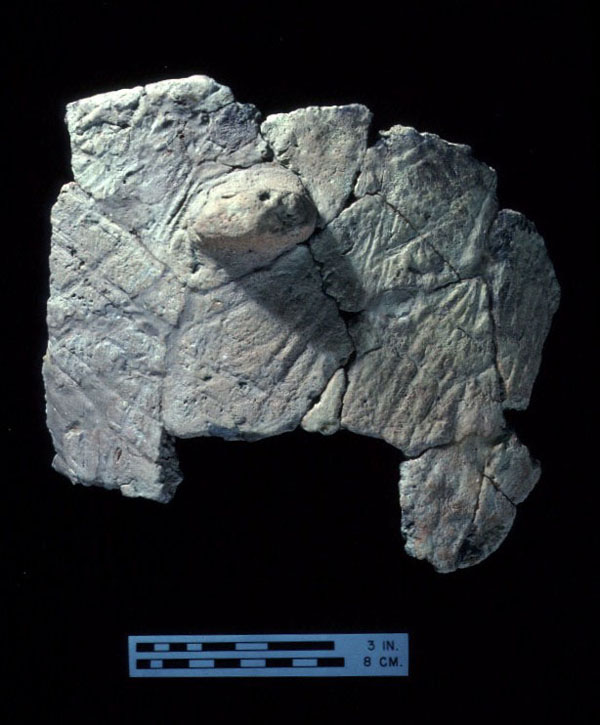Ceramic Typology
Back to Native American Ceramics Home
The Native American Ceramic Web Module was created to present wares, defined by archaeologists to solve particular research problems, in a simple format for both researchers and the general public. Native American ceramics in Virginia represent a three-dimensional puzzle of continuous style development through space and 3,200 years of time. In general, defined wares conform to the geographical provinces and the river drainages of Virginia. Archaeologists define wares that reflect variables of methods of manufacture, space and time. Analytical units of this kind are referred to as historical wares. A ware is a grouping of pottery of a similar method of manufacture, paste, temper, and vessel forms that occur in a certain locality at a particular period of time. A type is a class of ceramics of one ware that share the same surface treatment. This wealth of pottery information provides archaeologists with ways to help date sites and to define Native American groups and interpret their interaction and movement.
 Prehistoric artifacts are a mystery, unlike historic artifacts which are familiar to most of us through painting and pattern books. There is no way of placing prehistoric artifacts in time and give them meaning without archaeology. In order to make sense from artifacts, archaeologists first create types from comparing similar artifacts like sherds of pottery.
Prehistoric artifacts are a mystery, unlike historic artifacts which are familiar to most of us through painting and pattern books. There is no way of placing prehistoric artifacts in time and give them meaning without archaeology. In order to make sense from artifacts, archaeologists first create types from comparing similar artifacts like sherds of pottery.
With pottery, it’s the attributes of the sherds that are most important in typology. The sherds themselves are less important. The archaeologist assembles the attributes into an idealized ware with types. There is an underlying assumption in typology theory: only one ware, with accepted variations, was made by one cultural group of people in one region at one period of time.
Ceramic variation occurs naturally through time and across space. Normally, pottery changes slowly when the Native American group is isolated, but a ceramic can change very fast when there is dynamic cultural interaction. In this case, the artisan’s incorporates new attributes and fails to replicate the old form of the object. When ceramic change is slow, it is difficult for archaeologists to decide where along the continuum of variation to draw the dividing line between two wares.
The site context and the expertise of excavating the site affect typology. Sherds from a well excavated restricted context with secured radiometric dates, like a house floor, a burial, sealed strata, or pit feature, form the best defined wares. Sherds from a less restricted context, like a midden layer or a plow zone, form wares that are more generalized and less culturally meaningful.
How an archaeologist identifies the attributes and defines the ware affects the potential avenue of cultural interpretation. For example, a ware is most often used as a Historic Type to discuss time & space, but it may be used as a Functional Type to discuss the various uses of bowls, jars, storage vessels, and salt pans. A ware could be used as a Social Type to discuss food preparation, food storage, and food serving. Also, it may be used as an Ideology Type to talk about “trade” sherds, or exotic vessels in burials or vessels associated with ceremonial structures.
The sequence in which the attributes are analyzed may affect the archaeologist interpretation of the ware. For instance, most people use paste/temper as the first attribute to divide wares. But what would happen if archaeologists first used surface treatment or decoration to sort sherds from a site?
When analyzing sherds, archaeologists like to have a large sample from a site or adjacent sites, in order to see the entire variation in pottery from that region. Archaeologists are then more able to compare and contrast the ceramics. After all, a sherd is just a sherd, but a large collection of sherds can be divided into informative groups.
Sherds stored in drawers and boxes have a way of changing with the passage of time. Of course sherds don’t change; it is the archaeologist’s knowledge of the meaning of the attributes of the sherds that change. Sherds, due to interpretive implications, are living entities that appear to change through time. This illustrates the immense importance of collection management—proper storage and retrieval of artifacts. Also, it illustrates the value of curators that have spent their life handling and interpreting artifacts.
See Also:
 Prehistoric artifacts are a mystery, unlike historic artifacts which are familiar to most of us through painting and pattern books. There is no way of placing prehistoric artifacts in time and give them meaning without archaeology. In order to make sense from artifacts, archaeologists first create types from comparing similar artifacts like sherds of pottery.
Prehistoric artifacts are a mystery, unlike historic artifacts which are familiar to most of us through painting and pattern books. There is no way of placing prehistoric artifacts in time and give them meaning without archaeology. In order to make sense from artifacts, archaeologists first create types from comparing similar artifacts like sherds of pottery.